Futureproofing wind work
02 February 2021
Transport firms futureproof fleets with trailer combinations for increasingly long wind turbine blades.
Almelo, Netherlands-based Bolk Transport and Paderborn, Germany-based Universal Transport are both using self-steering trailer combinations from Oppenau, Germany-headquartered trailer manufacturer Doll Fahrzeugbau to transport increasing numbers of long wind turbine blades.
Both chose hydraulic lifting adapters on a dolly, giving themselves enough reserve capacity to accommodate the steady increase in rotor blade length and weight that the industry is experiencing, explained Doll. With a dead weight of approximately seven to 7.3 tonnes (depending on the choice of equipment) and a maximum fifth-wheel load of 30 tonnes, the dolly has a remaining load capacity of around 23 tonnes. Working at the other end of the system, the four-axle vario self-steering trailers have a load capacity of around 32 tonnes with a total technical weight of 40 tonnes. Doll said these trailer combinations make it easy to plan for a range of rotor blade sizes, up to almost to 100 metres in length.
Bolk Transport has three of these systems, the last two of which it collected before Christmas. “You need three vehicles, one for each blade,” explained Bolk managing director Joop Savenije. Previously, Bolk had relied solely on telescopic trailers to transport wind power components. As rotor blades began growing past 65 metres in length, Bolk started looking for alternatives. “We’re now increasingly seeing blades approaching 75 metres long – and they’re getting heavier, too”, says Savenije. “We found that Doll’s self-steering trailer combinations offered the best solution for what we needed.”
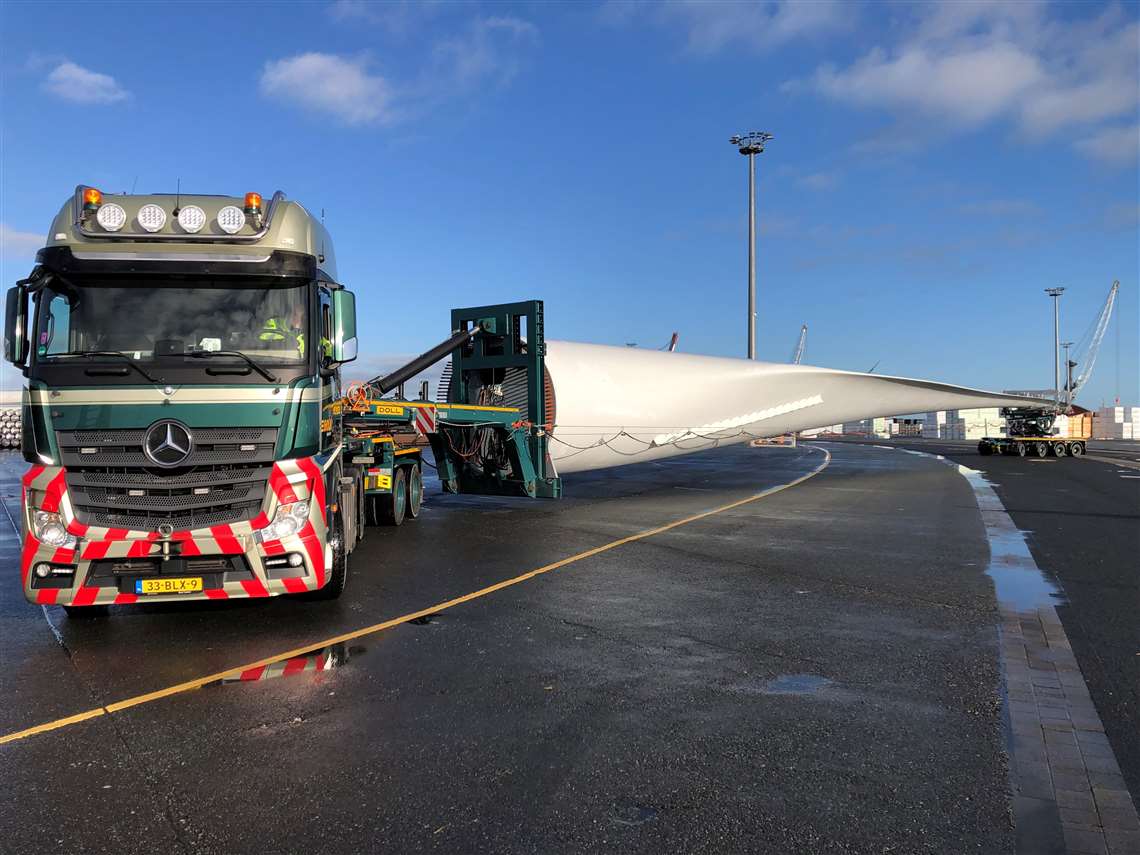 Trial loading at the Seaport of Brake: Bolk Transport used the new DOLL combination to carry the first 65-metre blade in mid-January
Trial loading at the Seaport of Brake: Bolk Transport used the new DOLL combination to carry the first 65-metre blade in mid-January
In mid-January 2021, the first trial loading operation took place at the seaport of Brake, Germany, where Bolk project manager Emil Leushuis commented, “What makes the trailer technology so good is that the rotor blade is self-supporting and there are much more flexible options for navigating obstacles. There’s also a tiltable lifting adapter at the front, and the equipment is able to get round bends much more smoothly. The extensive slewing angle and attached turntable make it possible to position the dolly and self-steering trailer at an almost entirely transverse angle to the bolster, while the vehicle keeps on going.”
Universal Transport has been using its three latest Doll self-steering trailer combinations since August 2020. “We’re currently using the trailers to carry rotor blades measuring as much as 65 metres long, on vehicles with a total length of up to 77 metres,” said Universal driver Ronny Knoblauch. “The extendable cable and rope systems provide 120 metres in length, so there’s practically no limit to how far you can take the system – which isn’t the case with telescopic trailers. “As there’s no telescopic beam, you’re left with much more room to cross over obstacles underneath the load. That means we don’t have to move nearly as many crash barriers aside when we encounter them on our outward and return journeys. The system is also a lot more agile. I can navigate roundabouts relatively easily with the traction unit and dolly, for instance, and the self-steering trailer simply follows me round. The turntable on the trailer gives you a huge slewing range at the rear, so you can keep driving straight at the front for a long time. The nature of the system means it’s even more important to have a second person involved so that they can give you feedback and intervene in the steering at any time – but on the whole, the handling is much smoother than it is in a telescopic trailer. And the system’s actually fun to drive.
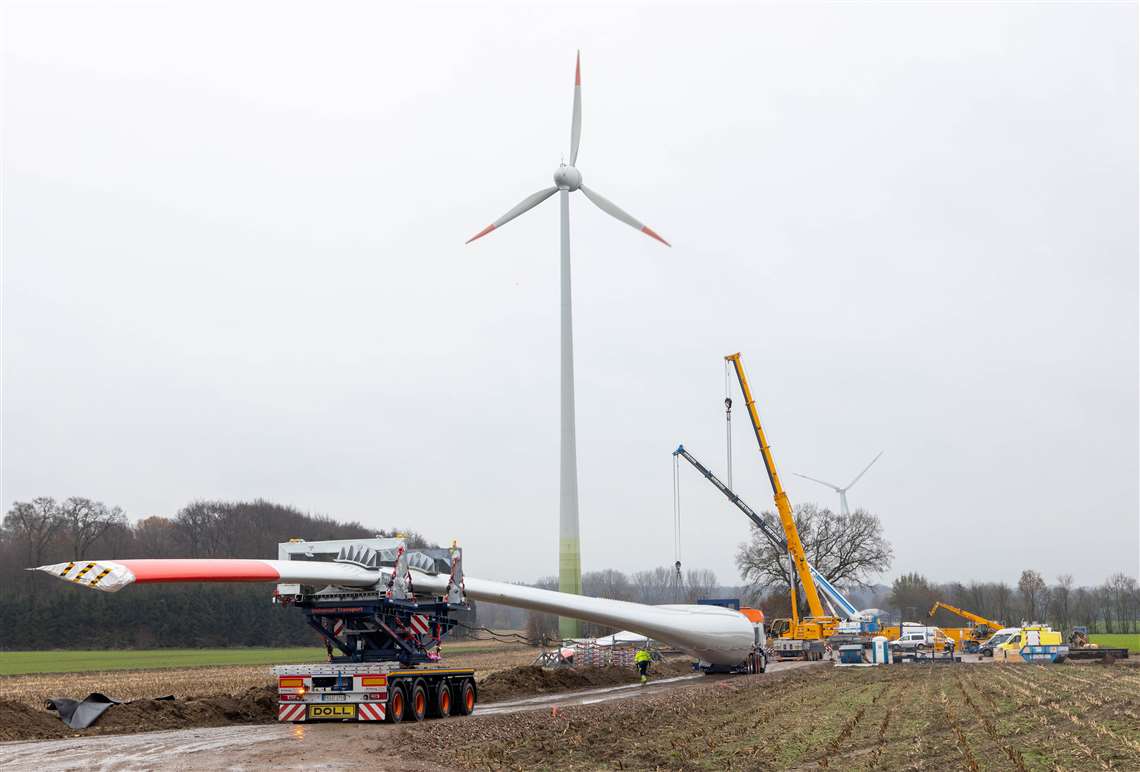 Universal Transport has been using its three latest Doll self-steering trailer combinations since August 2020
Universal Transport has been using its three latest Doll self-steering trailer combinations since August 2020
“I can release the hydraulic lifting adapter on the dolly by as much as 80 cm, which is handy in situations like manoeuvring over a traffic island or crouching down to road level to get under a low sign gantry.”
Holger Dechant, managing director of Universal Transport, added, “The new combinations have consistently shown us how reliable they are. Rotor blades are getting longer all the time, and we have to respond to that.
“The goalposts in the wind energy industry are moving all the time – partly as a result of policy and partly because of equipment manufacturers. That means the volumes of transport to do with the industry are always changing and we’re constantly having to rise to new challenges to do with equipment dimensions – that affects rotor blades most of all, but it also affects towers and nacelles, of course. Conventional telescopic trailers just aren’t cutting it anymore. The equipment is getting more and more specialised, and it’s no secret to say that it’s becoming more expensive too”.
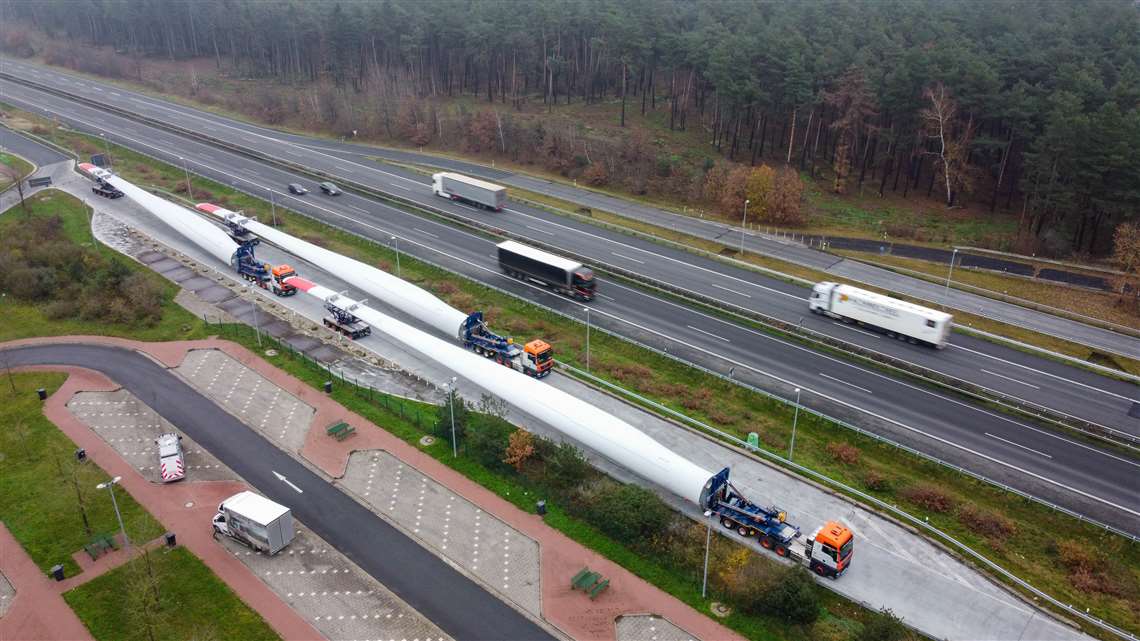 Carrying rotor blades measuring 65 metres long, the Universal Transport drivers have to operate a total vehicle length of around 77 metres. This can go up to more than 100 metres
Carrying rotor blades measuring 65 metres long, the Universal Transport drivers have to operate a total vehicle length of around 77 metres. This can go up to more than 100 metres
According to Doll, to ensure investments pay off in the face of a fluctuating market, equipment needs to demonstrate a high degree of flexibility alongside its specialist features. “We combine the trailers with different dollies to transport other long materials such as concrete parts and bridge girders,” said Dechant. “If rotor blades do reach 100 m in length, we’ll have what it takes to cope with that.”
|
Technical data Self-steering trailer Doll (vario N4S-0175) Total vehicle length (incl. drawbar): 7.590 mm Vehicle width: 2.550 mm Length of platform: 6.275 mm Bolster upper edge loading height (loaded): 1.395 mm Total weight techn. (80/60 km/h): 40.000/41.200 kg Body: Ball bearing turntable mounted with breaker for attaching the Doll bolster; up to 48 t load, max. bolster angle 85° to the left and right Running gear: 4 BPW axles with pneumatic suspension and drum brakes, 2 with ABS, all with ASA, 1st and 2nd axle on bogie with slewing ring, 3rd and 4th axle rigid; Tyres 245/70 R 17,5. 1st axle steering +/- 55°; radio remote control operates the additional steering Lift adapter for wind turbine blade, hydraulic liftable (DOLL X0H-0S2S32-Dolly) H x W x L: ca. 3.800 x 2.950 x 6.200 mm Coupling height: approx. 1.600 mm Slewing radius: 3.750 mm 5th wheel load (max.): 30.000 kg Body: Intermediate frame with root frame attachment; Mounting of a lifting cylinder that for lifting and lowering the wind blade, maximum lift above the ground: approximately 800 mm |
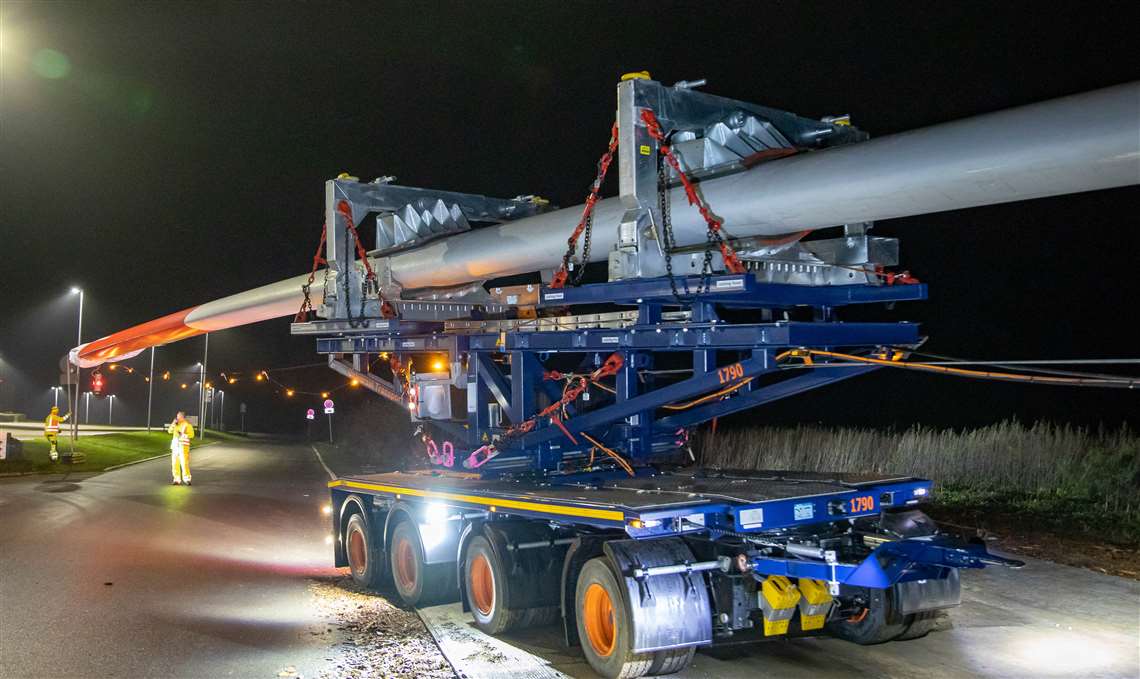 Doll’s self-steering trailer (N4S-0175)
Doll’s self-steering trailer (N4S-0175)
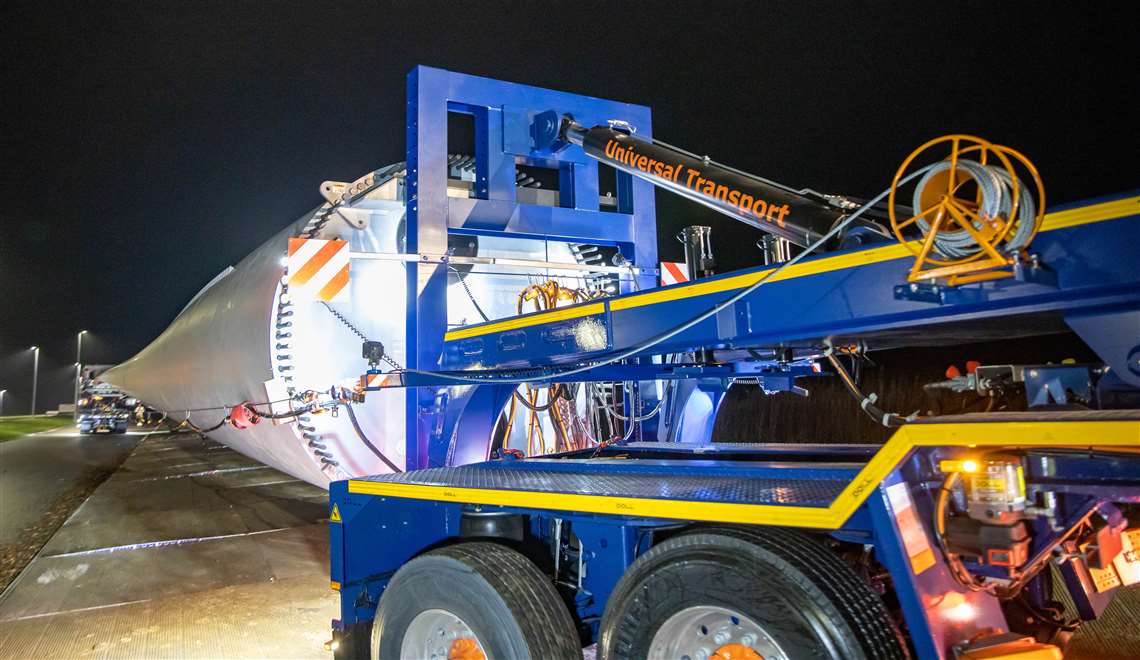 With a total stroke of 800 millimetres, Doll says the lifting adapter can help pass under low bridges or over crash barriers
With a total stroke of 800 millimetres, Doll says the lifting adapter can help pass under low bridges or over crash barriers
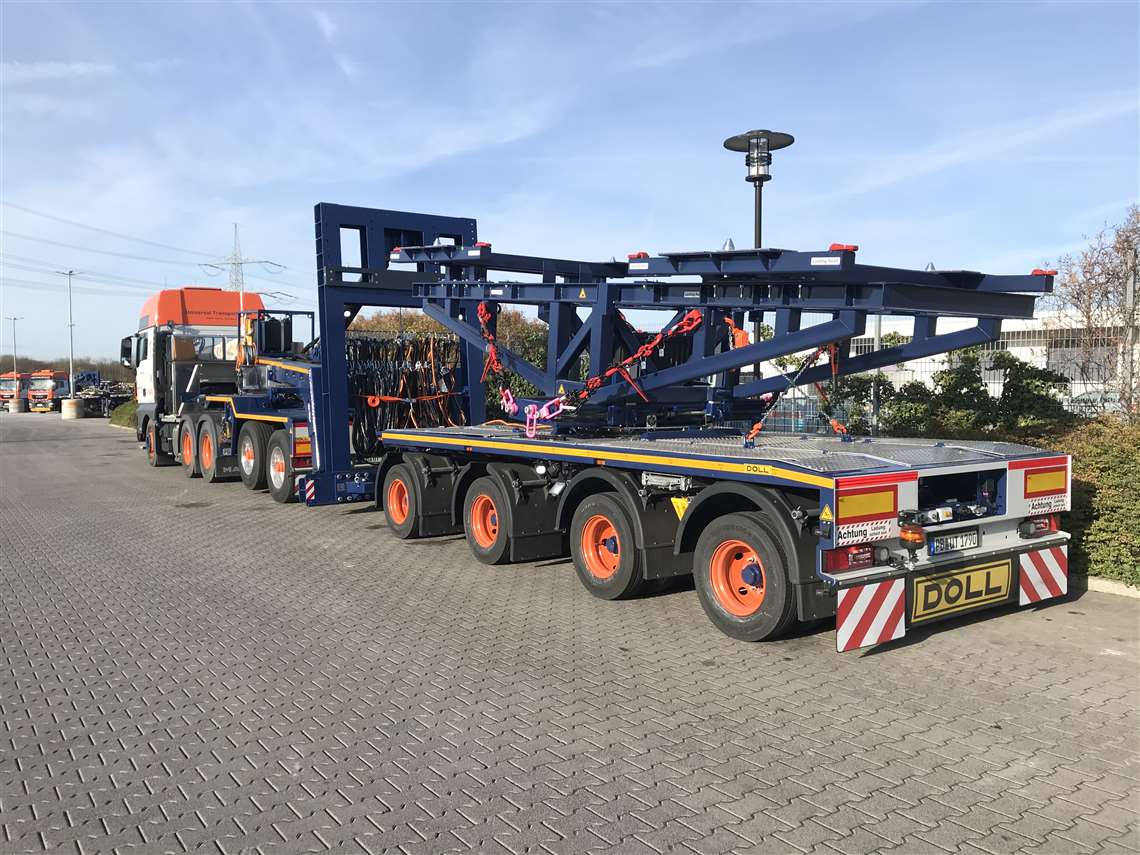 During empty trips, the self-steering-trailer and the dolly with lifting adapter and traction unit can be secured in compact way
During empty trips, the self-steering-trailer and the dolly with lifting adapter and traction unit can be secured in compact way
STAY CONNECTED


Receive the information you need when you need it through our world-leading magazines, newsletters and daily briefings.



